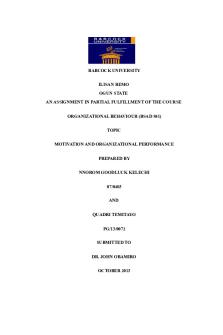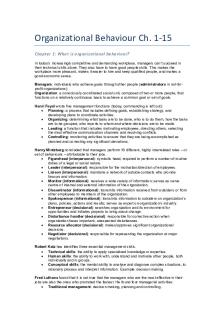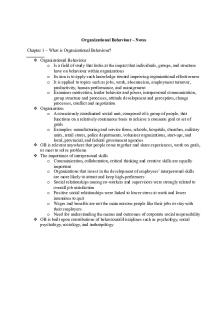COMM222-Summaries - Summary Organizational behaviour and theory PDF

| Title | COMM222-Summaries - Summary Organizational behaviour and theory |
|---|---|
| Author | Matthew Bonyad |
| Course | Organizational behaviour and theory |
| Institution | Concordia University |
| Pages | 59 |
| File Size | 2.3 MB |
| File Type | |
| Total Downloads | 251 |
| Total Views | 619 |
Summary
Chapter 2- Personality & LearningLO2 Define personality & discuss its general role in influencing organizational behaviourLO2 Describe the dispositional, situational, and interactionist approach to organizational behaviour and trait activation theory.★ Personality is the relatively ...
Description
Chapter 2- Personality & Learning LO2.1 Define personality & discuss its general role in influencing organizational behaviour LO2.2 Describe the dispositional, situational, and interactionist approach to organizational behaviour and trait activation theory. ★ Personality is the relatively stable set of psychological characteristics that influences the way an individual interacts with his/her environment. It is reflected in the way people react to other people, situations, & problems. Dimensions & traits/attributes that are determined by genetic predisposition & one’s log-term learning history. ★ The role of personality in organizational behaviour has often been debated in what is known as the “person-situation debate.” This has led to three approaches: ○ Dispositional approach (disposition and personality): Individuals possess stable traits/attributes or characteristics that influence their attitudes and behaviours (from within). Individuals are predisposed to behave in certain ways. ○ Situational approach: Characteristics of the organizational setting such as rewards and punishment influence people’s feelings, attitudes and behaviour (from environment). ○ Interactionist approach (the most accepted perspective in OB): Organizational behaviour (individuals’ attitudes & behavior) is a function of both disposition & the situation. ● ● ● ● ●
To predict & understand organizational behavior, we need to know about individuals’ personality & the work setting. Some personality characteristics are useful in certain organizational situations. There is no one best personality. Managers need to appreciate the advantages of employee diversity. The importance of putting the right person in the right job/group/organization.
○ Trait activation theory: traits lead to certain behaviours only when the situation makes the need for the trait. ★ Situations can be described as being either “weak” or ● d ● In weak situations, roles are vaguely defined, punishment contingencies. Personality has the ● s ● In strong situations… opposite. T he extend to behavior depends on the situation.
“strong”. there are few rules & weak reinforcement & strongest effect. which personality affects peoples’ attitude and
LO2.3 Discuss the Five-Factor Model of Personality. ★ The Five Factor Model of personality: OCEAN Psychologists discovered that there are five basic & general dimensions that describe personality: ●
Openness to Experience → Curious, original vs. dull/boring, unimaginative. Important for jobs that involve learning & creativity given the tendency to be intellectual, curious, & imaginative and have broad interest.
●
Conscientiousness→ Dependable/reliable, responsible vs. negligent, impulsive. Important for job performance on most jobs given the tendency towards hard work & achievement.
●
Sociable, talkative, friendly vs shy, introverted, reserved. Important for jobs that require Extraversion→ interpersonal interaction & where being sociable, assertive, energetic, & ambitious is important for success.
●
Tolerant, cooperative vs. cold, rude. Contribute to job performance in jobs that require Agreeableness → interaction and involve helping, cooperating, and nurturing/supporting others as well as in jobs that involve teamwork and cooperation.
●
Stable, confident vs. depressed, anxious. Persons high on emotional Neuroticism/Emotional Stability → stability will have + effective interactions with co-workers & customers as they tend to be more calm & secure.
Research Support of the FFM of Personality: Each of the “Big Five” dimensions is related to job performance & organizational citizenship behavior ( individual behavior that is discretionary; it is not explicitly recognized by the formal reward system, it promotes the effective functioning of the organization). Conscientiousness is the best predictor of performance. The “Big Five” dimensions are also related to motivation, job & life satisfaction.
LO2.4 Describe & discuss the consequences of locus of control, self-monitoring, & self-esteem. ★ Locus of control is a set of beliefs about whether one's behaviour is controlled mainly by internal or external forces. Internals believe that the opportunity to control their own behavior, resides within themselves. They are more satisfied with their jobs, more committed to their organization, earn more money, and achieve higher organizational positions. High "internals" see stronger effects on their behaviour as a consequence of self-initiative. They perceive less stress. + career planning. They are + satisfied with their lives. Externals believes that external forces determine their behavior. High "externals" see their behaviours controlled by factors like fate, luck & powerful people. Self-monitoring is the extent to which people observe and regulate how they appear and behave in social settings and relationships. ●
Low self-monitors act like they feel and say what they think without regard to the situation.
●
High self-monitors behave somewhat like actors, taking great care to observe and control the images that they project. High self-monitors: ○ Concern for socially appropriate emotions and behaviors, and turn into social and interpersonal cues/signals. ○ Are not comfortable in ambiguous social settings in which is hard to determine what behaviors are socially appropriate. ○ High self-monitors gravitate to jobs that require role-playing and the use of their self-presentation skills.
○ Are + involved in their jobs, perform better, +likely to emerge as a leaders. ○ Experience + role stress and show - commitment to their organization. ○ +likely to change employers and locations. Self-esteem is the degree to which a person has a p ositive self-evaluation. People with high self-esteem (more resilient) make more fulfilling career decisions and have higher job satisfaction and job performance. They have favourable self-images. Employers with low self-esteem react badly to negative feedback -it lowers subsequent performance. According to behavioural plasticity theory, people with low self-esteem tend to be more susceptible to external & social influences than those who have high self-esteem. LO2.5 Define learning and describe what is learned in organizations. ★ Learning occurs when practice or experience leads to a relatively permanent change in behavior potential. It is the practice or experience that prompts/produce learning stems / arises from an environment that provides feedback concerning the consequences of behavior. What employees learn? -Practical Skills: job specific skills, knowledge, technical competence -Intrapersonnal Skills: problem solving, critical thinking, alternative work processes -Interpersonnal Skills: Interactive skills (communicating, teamwork & conflict resolution) -Cultural awareness: Social norms of org., company goals, business operations, expectations & priorities.
LO2.6 Explain operant learning theory & differentiate between positive & negative reinforcements . How do people learn? (operant learning and social cognitive theory) ★ Operant learning theory the subject learns to operate on the environment to achieve certain consequences. It is learning by doing, by operating in the situation you learn to do the task better. Reinforcement is the process by which stimuli strengthen behavior. It is a stimulus that follows some behavior and increases or maintains the probability of that behavior. ●
Positive Reinforcement : increases or maintains the probability of some behaviour by the application or addition of a s timulus to the situation in question. Though + reinforcers tend to be pleasant stimuli, this is not always true since the resultant increase or maintenance of behaviour determines whether or not a given stimulus was a + reinforcer.
●
Negative Reinforcement: increases or maintains the probability of some behaviour by the removal of a negative stimulus from the situation in question. It occurs when a response prevents some event or stimulus from occurring. Removes an impediment to someones performance (I.e. restrictive workspace, noisy environment). The removed or prevented stimulus is a negative reinforcer.
Errors involving reinforcement:
●
Confusing rewards with reinforces: rewards fail to serve as reinforces when they are not made contingent/possible on some specific desired behaviors.
●
Neglecting important sources of reinforcement such as... ●
Performance feedback: involves providing qualitative or quantitative information on past performance for the purpose of changing or maintaining performance in specific ways. It is + effective when: ○ ○ ○ ○
●
●
It is conveyed in a positive manner Represented visually Delivered immediately Specific to the behavior.
Social recognition; involves informal acknowledgement, attention, praise, approval, or genuine appreciation for work well done for one individual or group to another.
Neglecting diversity in preferences for reinforces.
LO2.7 Explain when to use immediate versus delayed reinforcement and when to use continuous versus partial reinforcement. ●
For fast acquisition of some response, continuous and immediate reinforcement should be used.
●
Behaviour tends to be persistent when it is learned under conditions of partial and delayed reinforcement.
LO2.8 Distinguish between extinction and punishment and explain how to use punishment effectively. Strategies that reduce the probability of learned behavior: ●
Extinction is the gradual dissipation of b ehaviour following the t ermination of r einforcement. If the behaviour is not reinforced, it will gradually dissipate or be extinguished. Extinction works best when coupled with the reinforcement of some desired substitute behavior.
●
Punishment : application of an aversive stimulus following unwanted behaviour to decrease probability of that behaviour . A nasty stimulus is applied after some undesirable behavior in order to decrease the probability of that behavior. Problems using punishment: ● It does not demonstrate which behaviors should replace to punish response ● Punishment indicates only what is not appropriate ● Temporarily suppresses the unwanted behavior ● Can provoke a strong emotional reaction Using it effectively:
● ● ● ●
Limit the emotions involved in the punishment Provide and acceptable alternative response for the punished response Make sure the punishment is truly aversive Punish immediately or reinstate the circumstances surrounding the problem behavior at a more appropriate time.
LO2.9 Explain social cognitive theory & discuss observational learning, self-efficacy beliefs, & self-regulation ★ Social Cognitive Theory (emphasizes the role of cognitive processes in regulating people’s behavior) is when people learn by observing the behaviour of others. Individuals also manage their own behaviour by thinking about the consequences of their actions, setting performance goals, monitoring their performance and comparing it to their goals, and rewarding themselves for goal accomplishment. Human behaviour can best be explained through a system of triadic reciprocal c ausation in which personal & environmental factors work together & interact to influence people’s behaviour. The three components for sustained SCT: Observational Learning: The process of observing and immitating the behaviour of others: ○ Seeing the consequences they experience ○ Thinking what may happen if we act the same way ○ Imitating the behavior if we expect favourable consequences The reinforcement is self-reinforcement: Attractive, credible, competent, high-status people are most likely to be imitated.
Self-efficacy refers to beliefs people have about their ability to successfully perform a specific task (u have to believe you can do it). It is a cognitive belief that is task specific & it is the result of 4 sources of information: performance mastery; observation; verbal persuasion & encouragement; & physiological state
Self-efficacy beliefs influence the activities people choose to perform, the amount of effort and persistence devoted to a task, affective and stress reactions, and job performance.
Self-regulation involves observing your own behaviour, comparing it to a standard (model), and rewarding oneself (self-reinforcement) when behavior meets the standard. ●
●
Discrepancy reduction and discrepancy production lie at the heart of the self-regulatory process. ●
Discrepancy reduction: A discrepancy between one’s goals and performance which motivates one to modify their behaviour.
●
Discrepancy production: When individuals attain their goals they are likely to set higher and more challenging goals.
Self-regulation involves the following activities: ○ Collect self-observation data ○ Observe models ○ Set goals ○ Rehearse ○ Reinforce oneself
●
Self-regulation can improve learning and result in a change in behaviour.
●
Self-regulation training has been shown to improve work attendance and sales performance.
●
Self-regulation has been shown to change a variety of behaviours and it is an effective method of learning and training.
Chapter 3- Perception, Attribution, & Diversity LO3.1 Define perception & discuss some of the general factors that influence it. ★ Perception is the process of interpreting the messages of our senses to provide order and meaning t o the environment.
People base their actions on the interpretation of reality that their perceptual system provides, rather than on reality itself. Among the most important perceptions that influence organizational behaviour are omponents of perception (each the perceptions that organizational members have of each other. C component influences the perceiver’s impression):
●
Perceiver: Past experiences lead the perceiver to develop expectations that affect current perceptions. Emotions can influence our perceptions. Perceptual defense: ● ● ●
●
Tendency for the perceptual system to defend the perceiver against unpleasant emotions. People often “see what they want to see” & “hear what they want to hear” Our perceptual system works to ensure we do not see or hear things that are threatening
Situation: Add info about the target (the most important effect). The perception of the target can change when the situation change even when the perceiver & the target remain the same. Perception occurs in some situational context; this context can affect what is perceived
●
Target: ● ● ●
Ambiguous targets are especially susceptible to interpretation and the addition of meaning. The perceiver does not or cannot use all the information provided by the target. A reduction in ambiguity might not be accompanied by greater accuracy.
LO3.2 Describe Bruner’s model of the perceptual process. Bruner’s model of the perceptual process. ● ● ● ● ● ●
When the perceiver encounters an unfamiliar target, the perceiver is very open to the informational cues (senses) in the target and the situation. The perceiver will actively seek out cues to resolve ambiguity. As the perceiver encounters some familiar cues, a crude categorization of the target is made. The search for cues then becomes less open and more selective. The perceiver will search for cues that confirm the categorization of the target. As the categorization becomes stronger, the perceiver will ignore or even distort cues that violate initial perceptions.
Bruner’s model demonstrates three important characteristics of the perceptual process: ● ● ●
Perception is selective (pick-n-choose): Perceivers don’t use all the available cues Perceptual constancy: The tendency for the target to be perceived in the same way over time & across situations. Perceptual consistency: We want things to be the same. Tendency to select, ignore, and distort cues so that they fit together to for a homogeneous picture of the target.
LO3.3 Describe the main biases in person perception. ★ ●
Biases (precoincived notion of something) in person perception Primacy and recency effects ○ Primacy is the tendency for perceivers to rely on early cues or first impressions. It can have a lasting impact. It is also a form of selectivity and its lasting effects illustrate the operation of constancy. ○ Recency the tendency to rely on the recent cues or last impressions (li count +)
●
Reliance on central traits (powerful influence on our perception of others) ○ Could be physical appearance. ○ Personal characteristics of a target person that are of interest to a perceive. ○ Conventionally attractive people fare better in term of job-related outcomes. ○ Physical height is an obvious aspect of physical appearance that is related to job performance, promotion, and career success. Overweight →negatively evaluated
●
Implicit personality theory: personal theories that people have about which personality characteristics go together. I.e. we expect that hard working people to also be honest, or people of avg intelligence to be most friendly.
●
Projection (tendency to find some familiarity): attributing your own feelings and thoughts to others.
●
Stereotyping is the tendency to generalize about people in a s ocial category and ignore variations among them (ex. all scientist are bright and all football players are ignorant.) Specific aspects to stereotyping: ○ We distinguish some category of people. ○ We assume that the individuals in this category have certain traits.
○ We perceive that everyone in this category possesses these traits (generalization). Stereotypes help us develop impressions of ambiguous targets. Most stereotypes are inaccurate, especially when we use them to develop perceptions of specific individuals. Inaccurate stereotypes are often reinforced by selective perception. LO3.4 Describe how people form attributions about the causes of behaviour. LO3.5 Discuss various biases in attribution. ★ Attribution Theory: attribution is the process by which we assign causes or motives to explain people’s behaviour. An important goal is to determine whether some behavior is caused by dispositional or situational factors. ○ Dispositional attributions: person acts a certain way because of internal characteristics (personality, values, intelligence, desires, etc.) ○ Situational attributions: person acts a certain way because of the situation or the environment (bad weather, good luck, poor advice) Three attribution questions: ●
Does the person engage in the behaviour regularly & consistently? (Consistency cues). ○ Attribution cues that reflect how consistently a person engages in a behaviour over time. ○ High consistency behaviour leads to dispositional attributions. Behavior does not change over time. ○ When behaviour occurs inconsistently, we begin to consider situational attributions.
●
Do most people engage in the behaviour, or is it unique to this person? (Consensus cues). ○ Attribution cues that reflect how a person’s behavior compare with that of others. ○ Low concensus behavior leads to dispositional attributions (does not matter how the other people are, behavior does not change.)
●
Does the person engage in the behaviour in many ...
Similar Free PDFs
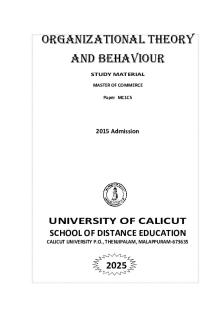
Organizational theory and behaviour
- 186 Pages
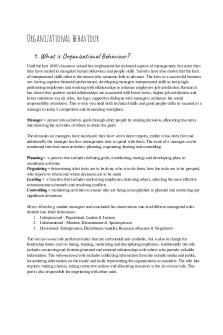
Organizational behaviour
- 67 Pages

Organizational Behaviour
- 2 Pages
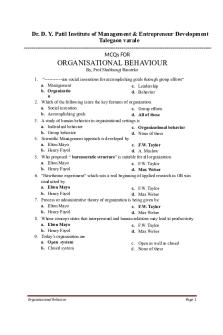
Organizational Behaviour mcqs
- 27 Pages
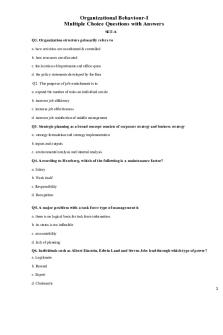
Organizational Behaviour MCQ SET
- 20 Pages
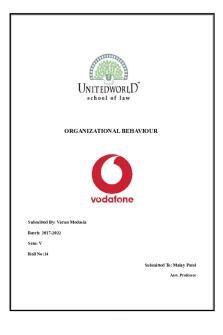
Organizational Behaviour Project
- 15 Pages

Chapter 2 ORGANIZATIONAL BEHAVIOUR
- 23 Pages
Popular Institutions
- Tinajero National High School - Annex
- Politeknik Caltex Riau
- Yokohama City University
- SGT University
- University of Al-Qadisiyah
- Divine Word College of Vigan
- Techniek College Rotterdam
- Universidade de Santiago
- Universiti Teknologi MARA Cawangan Johor Kampus Pasir Gudang
- Poltekkes Kemenkes Yogyakarta
- Baguio City National High School
- Colegio san marcos
- preparatoria uno
- Centro de Bachillerato Tecnológico Industrial y de Servicios No. 107
- Dalian Maritime University
- Quang Trung Secondary School
- Colegio Tecnológico en Informática
- Corporación Regional de Educación Superior
- Grupo CEDVA
- Dar Al Uloom University
- Centro de Estudios Preuniversitarios de la Universidad Nacional de Ingeniería
- 上智大学
- Aakash International School, Nuna Majara
- San Felipe Neri Catholic School
- Kang Chiao International School - New Taipei City
- Misamis Occidental National High School
- Institución Educativa Escuela Normal Juan Ladrilleros
- Kolehiyo ng Pantukan
- Batanes State College
- Instituto Continental
- Sekolah Menengah Kejuruan Kesehatan Kaltara (Tarakan)
- Colegio de La Inmaculada Concepcion - Cebu

